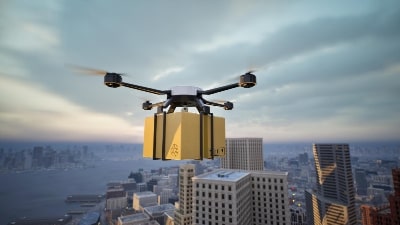Flying High: Exploring the Features and Specifications of Commercial and Industrial Drones

Commercial and industrial drones have revolutionized many industries, including agriculture, construction, and filmmaking. With their ability to capture high-quality aerial footage and gather data from difficult-to-reach locations, drones have become an essential tool for many businesses. In this article, we’ll explore the features and specifications of commercial and industrial drones, including the different types available and their uses.
Types of Commercial and Industrial Drones
There are several types of commercial and industrial drones available, each with its own unique features and specifications. Let’s take a closer look at the most common types:
- Fixed-Wing Drones
Fixed-wing drones are designed to fly like traditional airplanes. They have a long flight time and can cover large distances, making them ideal for surveying and mapping large areas. Fixed-wing drones are also used for crop monitoring and surveillance.
- Multi-Rotor Drones
Multi-rotor drones, also known as quadcopters, are the most popular type of commercial drone. They are highly maneuverable and can hover in one spot, making them ideal for aerial photography and videography. Multi-rotor drones are also used for inspection work and search and rescue operations.
- Hybrid Drones
Hybrid drones combine the features of both fixed-wing and multi-rotor drones. They have the long flight time of fixed-wing drones and the maneuverability of multi-rotor drones, making them ideal for a wide range of applications, including surveying, mapping, and inspection work.
Features of Commercial and Industrial Drones
- Camera
One of the most important features of a commercial or industrial drone is its camera. Drones can be equipped with a wide range of cameras, from basic models that capture low-resolution images to high-end models that capture 4K video and high-resolution images. Some drones even come with thermal imaging cameras, which are used for inspecting solar panels and detecting hotspots in buildings.
- GPS
Most commercial and industrial drones come equipped with GPS technology, which allows them to navigate and fly autonomously. GPS also enables drones to fly to specific locations and follow pre-programmed flight paths.
- Flight Time
The flight time of a drone is another important feature to consider. The flight time refers to how long the drone can fly on a single battery charge. Fixed-wing drones typically have longer flight times than multi-rotor drones, but the flight time of any drone depends on its battery capacity, weight, and other factors.
- Range
The range of a drone refers to how far it can fly from the operator’s location. Most commercial and industrial drones have a range of several miles, but this can vary depending on the type of drone and its specific features.
- Payload Capacity
The payload capacity of a drone refers to how much weight it can carry. This is an important consideration for drones used in industries such as agriculture and construction, where the drone may need to carry a camera or other equipment.
Specifications of Commercial and Industrial Drones
- Size and Weight
The size and weight of a drone can impact its flight performance and maneuverability. Smaller drones are more maneuverable but may have shorter flight times and smaller payloads, while larger drones are more stable in flight but may be less maneuverable.
- Motors
The motors of a drone are responsible for its flight performance. Most commercial and industrial drones use brushless motors, which are more efficient and durable than traditional brushed motors.
- Sensors
Drones can be equipped with a range of sensors, including GPS, accelerometers, and gyroscopes. These sensors help the drone maintain its position and stability in flight, and they also enable the drone to navigate autonomously.
- Flight Modes
Commercial and industrial drones typically have several different flight modes, including manual mode, GPS mode, and autonomous mode. In manual mode, the operator controls the drone’s flight manually. In GPS mode, the drone uses GPS technology to navigate and fly autonomously to specific locations. In autonomous mode, the drone follows a pre-programmed flight path and performs specific tasks, such as surveying or inspecting a building.
Uses of Commercial and Industrial Drones
Commercial and industrial drones are used in a wide range of industries, including agriculture, construction, and filmmaking. Let’s take a closer look at some of the most common uses of commercial and industrial drones:
- Agriculture
Drones are used extensively in agriculture to monitor crops and livestock. They can be equipped with cameras and other sensors to gather data on crop health and yield, soil moisture, and more. This data can be used to optimize crop management and improve crop yields.
- Construction
Drones are also used in the construction industry to survey construction sites and monitor progress. They can capture high-resolution images and videos of the site, which can be used to create 3D models and maps. Drones are also used for inspection work, such as inspecting bridges and buildings for damage.
- Filmmaking
Drones are becoming increasingly popular in the filmmaking industry due to their ability to capture high-quality aerial footage. They are used in a wide range of film and video productions, from documentaries to music videos.
- Search and Rescue
Drones are also used in search and rescue operations to locate missing persons or survey difficult-to-reach areas. They can be equipped with thermal imaging cameras, which are used to detect heat signatures and locate people in remote areas. In conclusion, commercial and industrial drones have revolutionized many industries, providing businesses with the ability to capture high-quality aerial footage and gather data from difficult-to-reach locations. With their unique features and specifications, commercial and industrial drones are used in a wide range of applications, from agriculture and construction to filmmaking and search and rescue operations. As technology continues to advance, the capabilities of commercial and industrial drones are sure to continue growing, opening up even more possibilities for businesses in the future.